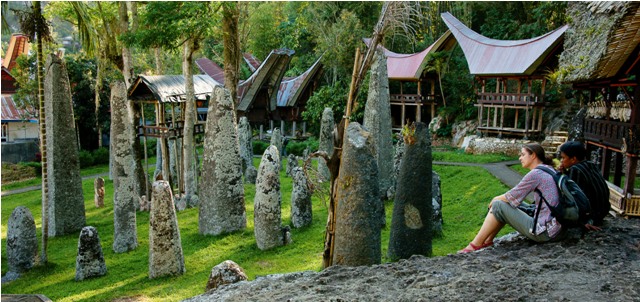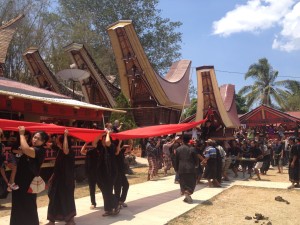The post Toraja People & The Funeral Ceremony appeared first on Toraja-Info.com.
]]>
Tana Toraja is a region located in South Sulawesi, Indonesia, a picturesque mountainous region that is home to an indigenous group known as the Torajans. For the Toraja people, life very much revolves around death, but not in a morbid sense. For them, a funeral is a great celebration of life, much like a going-away party, and is an occasion in which the entire family of the deceased, and all the members the village take part. Their ancient traditions involve funerary customs that have been practiced over many centuries and are known to be the most complex funeral traditions in the world.
The population of the Toraja is approximately 650,000, of which 450,000 still live in the regency of Tana Toraja or Toraja Land. Most are Christian, others are Muslim, and a minority still retain the local beliefs known as Aluk Todolo (The Old Religion), which are most visible during funeral festivities and burial customs.
Before the 20th century, Torajans lived in autonomous villages, where they practiced animism, the worldview that non-human entities, including animals, plants, and often even inanimate objects or phenomena possess a spiritual essence. They were relatively untouched by the outside world until Dutch missionaries arrived to convert the Torajan highlanders to Christianity. Nevertheless, even those that follow other religions in Tana Toraja, still converge when it comes to ancient funeral customs.
During their lives, the Torajans work extremely hard to accumulate wealth. But unlike other societies, the Torajans do not save their money to give themselves a good life, rather they save for a good send off in death. In fact, it is the extravagance of the funeral, not the wedding, which marks a family status.
Funeral ceremonies are incredibly important to the Torajans and are often held weeks, months, or even years after the death of a person to give the family of the deceased time to raise enough money for expenses a body is not buried until the funds have been raised. Many people go deeply into debt in order to hold a funeral ceremony and it is not uncommon for a young man, afraid of being burdened by debt, to postpone or cancel his marriage if a grandparent of the girl he loves is old enough to die soon. The funerals are raucous affairs involving the whole village and traditionally last for days or even weeks. Specifically, a funeral reinforces the eternal bond between the living and the dead.
Unique Toraja Funeral Ceremony Customs

When a people dies in Tana Toraja, family members of the deceased are required to hold a series of funeral ceremonies, known as Rambu Solo, over many days. During this time, the deceased is not buried but is embalmed and stored in a traditional house under the same roof with his or her family. Until the funeral ceremonies are completed, the person is not considered to be truly dead but merely suffering an illness. The dead relative is referred to simple as person who is sick or the one who is asleepRemarkably, this could even last several years after death, depending on how long it takes the family to raise money During this time, the deceased family member is symbolically fed, cared for and taken out, and is very much a part of their relative lives.
Their ceremony begins when funeral visitors attend a buffalo-slaughtering field. Family members are required to slaughter buffalos and pigs as they believe that the spirit of the deceased will live peacefully thereafter, continuing to herd the buffalos that have come to join him or her. Before being sacrificed according to a strictly defined procedure, the animals take part in trials of strength known as tedong silaga.
After the sacrifice, the meat is distributed to the funeral visitors in accordance with visitors’ positions in the community, and the spirit of the deceased is also entitled to a portion of meat, known locally as Aluk Todolo. The heads of the buffalos are returned to what is locally known as puya (a site for the soul or spirit of the dead person) and their horns placed in front of the house of the kinThe more horns that decorate the front of the house, the higher the status of the deceased.
The body is not buried until the eleventh day of the ceremony, although they are not technically buried the final resting place is in a cave up on the cliff. The soul of the deceased is thought to linger around the village until the funeral ceremony is completed, after which it begins its journey to the land of souls.

A wood-carved effigy called tau tau, carved with the likeness of the dead person is then placed in the balcony of the tomb to represent the dead and watch over their remains. Unfortunately, so many tau tau effigies have been stolen to be sold to tourists that people have started to keep them in their homes.

In one region, known as Kete kesu, the dead are not placed in cliff-dug graves, but in wooden caskets hanging from the side of cliffs. The coffins are beautifully decorated with geometrical shapes, but over time the wood begins to rot and the bleached bones of the deceased often become exposed.
 A Baby Tree – The smallest of the Toraja burial grounds are the Baby Trees where the tribe young are placed. If a child dies before he has started teething, the baby is wrapped in cloth and placed inside a hollowed out space within the trunk of a growing tree, and covered over with a palm fibre door. The belief is that as the tree begins to heal, the child essence will become part of the tree. Dozens of babies may be interred within a single tree.
A Baby Tree – The smallest of the Toraja burial grounds are the Baby Trees where the tribe young are placed. If a child dies before he has started teething, the baby is wrapped in cloth and placed inside a hollowed out space within the trunk of a growing tree, and covered over with a palm fibre door. The belief is that as the tree begins to heal, the child essence will become part of the tree. Dozens of babies may be interred within a single tree.
The post Toraja People & The Funeral Ceremony appeared first on Toraja-Info.com.
]]>The post The Mystery of Toraja Land appeared first on Toraja-Info.com.
]]> Pesta Tomate or the funeral ceremony in Toraja society is one of most important rituals. This ritual procession held to send the spirit of the death person to the Puya, the afterworld properly to avoid misfortune for the family.
Pesta Tomate or the funeral ceremony in Toraja society is one of most important rituals. This ritual procession held to send the spirit of the death person to the Puya, the afterworld properly to avoid misfortune for the family.
In Toraja word, a dead person called Tomate. Without proper ritual arrangement of the funeral, the spirit of the deceased can cause misfortune to its family. And of the most important ritual is the animal sacrifice. The animal sacrifice in funeral ceremonies is the main key of the Funeral Ceremony it self. They believe that this sacrifice is to ensure eternal life in the afterlife and to safeguard the descendants.
In the Funeral Ceremony location, the deceased will be placed at the high-roofed tower constructed at one and of the field within the ceremony area. At a funeral, bamboo pavilions are also constructed around the field for the family and guests.
The Torajan generally have two kind funerals ceremony, one is before the burrial or for the burrial, second funeral is could be years after burrial day. This called as Ma’Nene Ceremony or the ceremony of cleaning corpses. The souls of the dead can only go to Puya, the afterworld, when the entire rituals has been completed.
They believe the soul of the deceased will ride the souls of the slaughtered buffaloes and pigs to Puya, the afterworld. The buffalo has traditionally been a symbol of wealth and power and even land could be paid for in buffaloes. After the guest display their presents of pigs and buffaloes, the traditional Mabadong song and dance is performed. This is a ceremonial re-enactment of the cycle of human life and the life story of the deceased. It also farewell to the soul of the deceased, and rely the hope that the soul will arrive in the afterworld safely.
Ma’Nene Ceremony
 Every August each year, a ritual called Ma’Nene (Cleaning Corpses Ceremony) are takes place, and then Family members of the deceased exhuming their ancestors bodies by washed, groomed and change their clothes. The mummies are then walked around the village by following a straight lines path. Following the straight lines is consider important part of the ceremony. According to the myth, these lines are connected with Hyang, a spiritual entity with supernatural power. As this entity only move in straight lines, the soul of the deceased body must follow the path of Hyang.
Every August each year, a ritual called Ma’Nene (Cleaning Corpses Ceremony) are takes place, and then Family members of the deceased exhuming their ancestors bodies by washed, groomed and change their clothes. The mummies are then walked around the village by following a straight lines path. Following the straight lines is consider important part of the ceremony. According to the myth, these lines are connected with Hyang, a spiritual entity with supernatural power. As this entity only move in straight lines, the soul of the deceased body must follow the path of Hyang.
According to the ancient Torajan belief system, the spirit of a dead person must return to his village of origin. So if a person died on a journey, the family would go to the place of death and accompany the deceased back home by walking them back to the village. In the past, people were frightened to journey far, in case they died while they were away and were unable to return to their village.
The post The Mystery of Toraja Land appeared first on Toraja-Info.com.
]]>